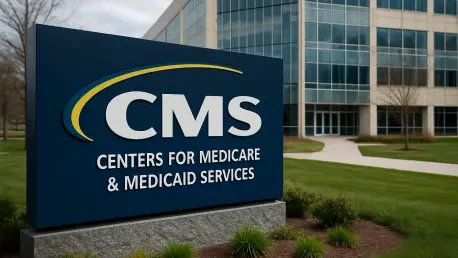In a landmark effort to transform the landscape of healthcare data management, the U.S. Centers for Medicare & Medicaid Services (CMS) has launched an innovative federal Health Technology Ecosystem, as announced by President Donald Trump at the White House. This bold initiative seeks to overhaul outdated practices, such as the reliance on fax machines for medical records, and pave the way for a more interconnected and efficient healthcare system. By prioritizing seamless data exchange and patient empowerment, CMS aims to address long-standing inefficiencies that have hindered progress in the industry. The project promises to leverage cutting-edge technology and broad collaboration to ensure that patients have unprecedented access to and control over their health information, marking a significant shift toward a more modern and responsive healthcare framework. As this ambitious plan unfolds, it sparks curiosity about how such a complex ecosystem will balance innovation with the critical need for privacy and security.
The Vision for a Connected Healthcare System
Interoperability as the Foundation
The cornerstone of this groundbreaking initiative lies in achieving true interoperability across the healthcare spectrum, a goal CMS is pursuing through the newly established CMS Aligned Network. This framework is designed to facilitate effortless data sharing among patients, providers, payers, and other key stakeholders, building on legislative foundations like the 21st Century Cures Act, which sought to eliminate information blocking. By creating standardized pathways for data exchange, the initiative aims to ensure that medical records are accessible in real-time, reducing delays and errors that often plague the current system. CMS envisions a future where disparate systems communicate seamlessly, allowing for more coordinated care and better health outcomes. This focus on connectivity represents a significant departure from fragmented practices, positioning interoperability as the bedrock of a more unified healthcare environment.
Beyond the technical aspects, the push for interoperability also carries profound implications for trust and collaboration within the healthcare sector. The CMS Aligned Network encourages voluntary participation from a wide array of entities, fostering a sense of shared responsibility to break down digital barriers. Industry experts note that such a collaborative approach could help standardize data formats and protocols, which have long varied across organizations, creating confusion and inefficiency. Moreover, the initiative’s alignment with federal mandates signals a strong governmental commitment to driving systemic change. While challenges remain in ensuring all participants adhere to these standards, the emphasis on interoperability sets a critical precedent for how technology can bridge gaps, ultimately benefiting patients who often bear the brunt of disconnected systems.
Patient Empowerment at the Core
At the heart of this transformative effort is a commitment to returning control over health data to patients, a vision articulated by key figures like U.S. Department of Health and Human Services Secretary Robert F. Kennedy, Jr., and CMS Administrator Dr. Mehmet Oz. The initiative seeks to dismantle the bureaucratic obstacles that have historically limited patients’ access to their own medical information, replacing outdated methods with intuitive digital tools. From mobile apps that help manage chronic conditions like diabetes to AI-driven chatbots for symptom assessment, the ecosystem promises to equip individuals with resources to take charge of their health. This shift aims to modernize interactions with healthcare providers, moving away from cumbersome paper forms toward streamlined digital solutions.
Equally important is the emotional and practical impact of empowering patients through accessible data. For too long, individuals have felt sidelined in a system that often prioritizes institutional needs over personal agency. By enabling direct access to medical records and fostering transparency, CMS hopes to rebuild trust between patients and the healthcare industry. The initiative also encourages the development of personalized health management tools, allowing users to choose applications that best suit their needs. However, the success of this patient-centric approach will depend on widespread education and adoption, ensuring that all demographics, including those less familiar with technology, can benefit from these advancements. This focus on empowerment marks a pivotal step toward a more inclusive and responsive healthcare model.
Technology and Innovation Driving Change
The Power of APIs
Central to the functionality of the new Health Technology Ecosystem is the adoption of an API-first approach, which promises to revolutionize how health data is accessed and utilized. Application Programming Interfaces (APIs) enable real-time data exchange between systems, a critical advancement highlighted by Dr. Don Rucker, former National Coordinator for Health IT. This technical foundation allows developers to create innovative applications tailored to patient needs, such as tools for tracking health metrics or scheduling appointments. By prioritizing APIs, CMS aims to break down the long-standing barriers that have restricted data flow under the pretext of privacy concerns, offering a more dynamic and flexible framework for healthcare interactions. The potential for such technology to streamline processes and enhance care delivery is immense, setting a new standard for the industry.
Furthermore, the emphasis on APIs opens the door to a wave of app-based solutions that could transform patient experiences in unprecedented ways. Imagine a scenario where a patient can instantly pull up their entire medical history on a smartphone, share it securely with a new provider, or receive personalized health recommendations based on real-time data. This level of connectivity not only saves time but also enhances the accuracy of medical decisions. Industry leaders believe that APIs could foster a competitive environment where developers continuously improve tools, driving innovation at a rapid pace. Yet, the effectiveness of this approach will hinge on ensuring that these interfaces are secure and accessible to all stakeholders, a challenge that CMS must address to maintain momentum in this technological shift.
Challenges in Data Usability
While interoperability sets the stage for better data sharing, a significant hurdle lies in ensuring that the shared information is usable across diverse systems, a concern raised by Dr. Mitesh Rao of OMNY Health. Interoperability alone does not guarantee that data will be complete, consistent, or formatted in a way that is easily actionable for providers or patients. Variations in how data is recorded and stored across different platforms often result in fragmented or incomplete records, which can undermine the benefits of connectivity. Addressing this issue will require additional frameworks to standardize data elements and ensure they can be interpreted uniformly, a task that extends beyond the current scope of the initiative but remains critical to its success.
Adding to the complexity is the sheer volume and heterogeneity of health data that must be managed within this ecosystem. Different providers and systems may use unique terminologies or coding structures, creating discrepancies that could lead to misunderstandings or errors in patient care. CMS will need to invest in solutions that transform raw data into meaningful insights, possibly through advanced analytics or machine learning tools that can harmonize disparate datasets. Collaboration with tech partners will be essential to develop these capabilities, ensuring that the data shared through the CMS Aligned Network is not just accessible but also practical for real-world applications. Overcoming these usability challenges will be a defining factor in whether the initiative achieves its transformative potential.
Collaborative Efforts Across Industries
Broad Stakeholder Engagement
A defining feature of this Health Technology Ecosystem is the extensive collaboration it has fostered among a diverse group of stakeholders, showcasing an unprecedented level of industry commitment. CMS has successfully rallied support from 60 technology companies, 21 health data exchange networks, 11 providers such as Intermountain Health, five payers, and seven electronic health record (EHR) vendors, including notable names like athenahealth and eClinicalWorks. These entities have voluntarily pledged to adhere to shared data exchange criteria within the CMS Aligned Network, forming a robust foundation for scalable progress. This broad engagement reflects a collective recognition of the need for a unified approach to modernize healthcare data management and improve patient outcomes.
The diversity of participants also ensures that multiple perspectives are considered in shaping the ecosystem, from clinical needs to financial implications. Providers and payers bring insights into practical challenges faced at the point of care, while tech firms and EHR vendors contribute expertise in digital infrastructure and innovation. This collaborative spirit is further evidenced by CMS’s open call for additional innovators to join the effort, suggesting a flexible and inclusive model designed to evolve over time. The voluntary nature of participation, while a strength in promoting buy-in, also raises questions about long-term commitment and accountability. Nevertheless, this wide-ranging partnership signals a promising start to addressing systemic inefficiencies through shared goals and resources.
Federal Leadership and Industry Buy-In
The pivotal role of CMS as the largest payer in the U.S. healthcare system provides unique leverage to drive systemic change, a point emphasized by eHealth Exchange president Jay Nakashima. With its substantial influence, CMS is well-positioned to set standards and encourage widespread adoption of the Health Technology Ecosystem’s principles. Federal leadership in this context not only provides direction but also instills confidence among industry players that the initiative has the backing and resources needed to succeed. The alignment with existing programs like the Trusted Exchange Framework and Common Agreement (TEFCA) further reinforces the government’s commitment to creating a cohesive national strategy for health data exchange.
Industry optimism about this federal push is palpable, with many stakeholders viewing it as a natural extension of prior interoperability efforts, now amplified by CMS’s authoritative role. Tech companies and health networks see potential in a unified system that reduces redundancy and enhances efficiency, ultimately benefiting both providers and patients. However, sustaining this momentum will require ongoing dialogue between federal agencies and private entities to address emerging challenges and refine strategies. The shared vision of a transparent, patient-centric healthcare system drives this collaboration, but careful coordination will be necessary to ensure that diverse interests remain aligned. This partnership between government and industry marks a critical step toward realizing a connected healthcare future.
Privacy and Security Concerns
Risks of Big Tech Involvement
As the Health Technology Ecosystem brings major technology firms into the fold, significant concerns arise about the potential misuse of sensitive health data, a worry voiced by critics such as the Center for Digital Democracy. The involvement of Big Tech, with histories of inconsistent data privacy practices, raises red flags about the possible monetization of personal medical information. Given the lucrative nature of health data in commercial markets, there is apprehension that patient information could be exploited for profit rather than protected for care. This ethical dilemma underscores the need for stringent oversight to prevent the ecosystem from becoming a gateway to unintended commercialization, a risk that could erode public trust in the initiative.
Moreover, the scale at which Big Tech operates amplifies the potential impact of any privacy misstep within this framework. A single breach or misuse could affect millions of individuals, given the vast datasets these companies might access through the CMS Aligned Network. Advocates argue that clear boundaries and enforceable regulations must be established to govern how these firms handle health information, ensuring that patient welfare remains the priority over corporate interests. While the technological expertise of these companies is invaluable to the ecosystem’s development, their participation must be balanced with robust accountability measures. Addressing these risks will be crucial to maintaining the integrity of the initiative and safeguarding patient confidence.
Vulnerabilities in Data Sharing
The technical mechanisms underpinning the new ecosystem, such as API-based exchanges and QR codes for transferring medical histories, introduce notable cybersecurity vulnerabilities that cannot be overlooked. Recent CMS data breaches, which impacted over 100,000 beneficiaries through fraudulent account creation, highlight the real-world risks of managing vast amounts of sensitive information. These incidents demonstrate how even well-intentioned systems can become targets for malicious actors if security protocols are not airtight. The reliance on digital tools for data sharing, while innovative, opens new avenues for potential exploitation that must be rigorously addressed to prevent further breaches.
Compounding these concerns is the complexity of securing data across multiple platforms and stakeholders involved in the ecosystem. Each point of access, whether through an app or a networked provider, represents a potential weak link that could be compromised if not adequately protected. Cybersecurity experts stress the importance of implementing advanced encryption, multi-factor authentication, and continuous monitoring to mitigate threats. Additionally, the rapid pace of technological adoption in healthcare often outstrips the development of corresponding security measures, creating gaps that need urgent attention. Strengthening these defenses will be paramount to ensuring that the benefits of data sharing are not undermined by preventable security failures.
Government Assurances vs. Public Skepticism
Despite the risks, CMS and the Office of Civil Rights (OCR) maintain that robust privacy protections are in place to safeguard the Health Technology Ecosystem, with OCR Director Paula Stannard emphasizing the importance of timely breach notifications. Official statements assert that existing regulations and new guidelines will ensure data security while enabling innovation, aiming to reassure the public about the government’s commitment to protecting health information. These assurances are intended to build confidence that the ecosystem can operate without compromising individual rights, highlighting a proactive stance on addressing potential issues before they escalate into widespread problems.
However, public and advocate skepticism persists, fueled by past incidents and the inherent challenges of securing digital health data on such a large scale. Digital rights groups argue that government promises, while well-intentioned, may not fully account for the sophisticated nature of modern cyber threats or the complexities of multi-stakeholder systems. The memory of recent breaches lingers, casting doubt on the ability to prevent future violations, especially with Big Tech’s involvement adding another layer of uncertainty. Bridging this trust gap will require transparent communication, demonstrable security successes, and a willingness to adapt policies based on real-world outcomes. Public perception will play a decisive role in the initiative’s acceptance and long-term viability.
Balancing Innovation and Protection
Navigating the delicate balance between fostering healthcare innovation and ensuring robust data protection emerges as a central challenge for CMS in this ambitious undertaking. The promise of enhanced interoperability and patient empowerment through advanced technology is undeniable, yet it must not come at the expense of exposing sensitive information to risks. Striking this equilibrium demands a multifaceted approach, incorporating strict regulatory frameworks, cutting-edge security technologies, and continuous evaluation of system vulnerabilities. Only through such comprehensive measures can the ecosystem achieve its transformative goals without sacrificing the trust of those it aims to serve.
Reflecting on the path ahead, it becomes evident that sustained collaboration between government, industry, and advocacy groups is essential to address these dual priorities effectively. CMS must prioritize the development of clear guidelines for data handling while investing in cybersecurity infrastructure to preempt threats. Engaging with privacy experts and affected communities to refine policies ensures that protective measures keep pace with technological advancements. These efforts, initiated with a focus on actionable safeguards, lay the groundwork for a future where innovation and security reinforce each other, offering a model for how healthcare can evolve responsibly in an increasingly digital world.









